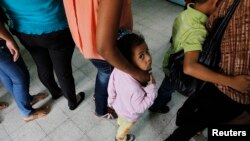The mass arrival of undocumented children to the U.S. southern border will not end so long as Central America remains a cauldron of violence, poverty, and desperation: that is the message U.S. lawmakers heard from a panel of experts who testified before the Senate Homeland Security Committee.
Central American parents who send their children on a perilous journey may incorrectly believe that minors have an automatic right to remain in the United States under current law and Obama administration policy, but that false impression is not the primary driver of mass-migration, according to Eric Olson of the Woodrow Wilson Center’s Latin American Program.
“For many, the long odds of coming north are better than the impossible odds of staying," said Olson.
That is because El Salvador, Honduras, and Guatemala have some of the highest murder and poverty rates in the world, according to the president of the Inter-American Dialogue, Michael Schifter, who also testified before the Senate panel.
"Today, more Salvadorans are being killed than during the worst moments of that country's bloody civil war in the 1980s. What these [Central American] countries all share is a crisis derived from weak institutions and governance. The capacity of these governments to protect their citizens and deliver basic services is very limited. Corruption is rampant," said Schifter.
Shifter adds that any U.S. initiative that fails to reach out to Central America and improve conditions at the community level will not stem the child migration crisis at the border.
“U.S. assistance should prioritize key institutions, such as the police forces and the courts. This is the best way to advance the rule of law. There is no quick fix. Any serious effort will take a long time," he said.
Olson noted that, in much of Central America, 50 percent or more of youngsters do not complete secondary education. A dearth of economic prospects in Central America must also be addressed, according to Eric Farnsworth of the Council of the Americas.
“One critical component of a solution, I believe, is the creation of realistic prospects for economic gain within migrant-sending nations. In other words, good, legal, sustainable jobs offering the prospects for a better life and stability at the local and community level," said Farnsworth.
While not dismissing desperate conditions in much of Central America, the committee’s top Republican, Senator Tom Coburn, said U.S. policies have helped draw child migrants to the border.
“When you ask the people who are coming here, when they are intercepted by the Border Patrol, 90 percent think there is a free pass [to enter the United States]," said Coburn.
But the committee’s chairman, Democrat Tom Carper, says an enforcement-only approach to the border crisis will fail.
“There are strong and entrenched problems in Central America that are driving so many to make the risky journey north. Unless we take a hard look at those underlying problems, we will keep spending money to treat the heart-breaking symptoms at our borders," said Carper.
President Barack Obama has requested nearly $4 billion in emergency funds to accommodate and process tens of thousands of child migrants, and to boost federal resources at the border. Some lawmakers want to amend a 2008 law assuring immigration hearings for most arrivals other than Mexicans.
Legislators of both parties say the border crisis should be addressed before Congress adjourns for its August recess.








